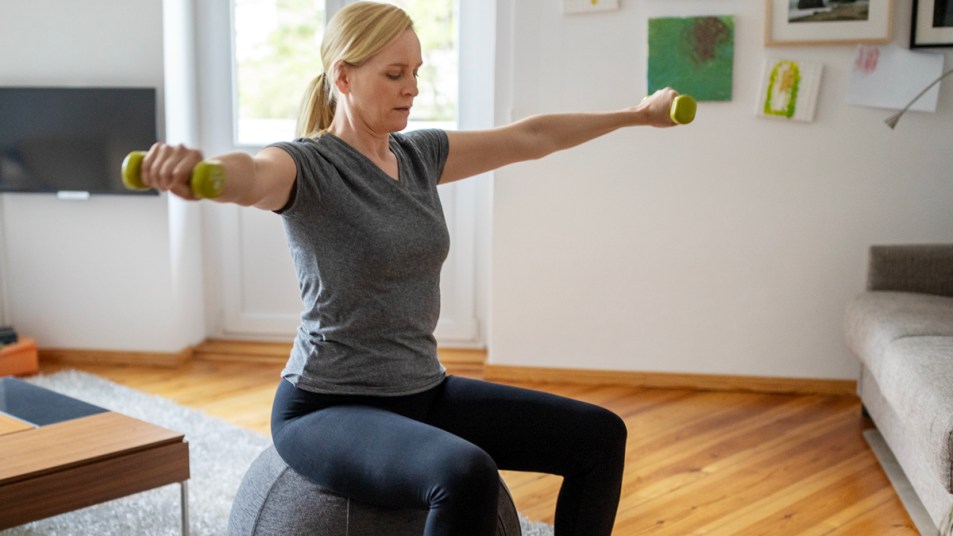How Weight and Resistance Training Can Help Boost Bone Health as You Age

Cardio is well known as the holy grail for promoting heart health and reducing body fat. But did you know that certain exercises, such as weight and resistance training, are crucial for improving bone strength and leading a healthier life?
A study published by the Journal of Bone and Mineral Research on January 15, 2021 showed that participants with strong arm and leg muscles were less likely to experience certain fractures than women with weak appendicular muscles — those that control the arms and legs and stabilize the shoulders and pelvis.
Just how important are muscle-building exercises to staying healthy in old age? According to investigators from Alias Media, one in two women will suffer from an osteoporotic fragility fracture, which is defined as any low-energy trauma fracture.
A fracture could be a devastating and permanent blow to your health. Staying strong is more important than ever, and it’s not too late to incorporate safe, muscle-building exercises into your health and wellness regime.
Findings from the Study:
In partnership with the Women’s Health Initiative (WIH), researchers for the Journal of Bone and Mineral Research wanted to increase awareness of the dangers that fractures and falls pose to older, postmenopausal women.
They began by collecting data from 11,187 women with an average age of 63 over the course of 20 years. Even after accounting for different health factors and variables, researchers discovered that women with a greater appendicular lean muscle mass (a measurement of the lean muscle tissue in the arms and legs) were at a lower risk for major osteoporotic fracture.
Researchers did acknowledge that appendicular lean muscle mass may not be the best predictor of a person’s fall and fracture risk. Still, previous studies have established that a lower lean muscle mass is a key indicator of lower bone mass. The National Institutes of Health Osteoporosis and Related Bone Diseases also confirms that bone, as a living tissue, responds to exercise by becoming stronger.
How to Safely Gain Muscle and Improve Bone Strength as You Age
If you want to boost your bone strength and gain muscle, the best thing you can do is add weight-bearing and resistance exercises to your routine.
Weight-bearing exercises are those that force you to work against gravity, such as walking, jogging, climbing stairs, dancing, playing tennis, or playing squash. These activities cause bone tissue to react to impact by building more bone cells, which leads to stronger bones. As a result, these activities are highly recommended in treating osteoporosis.
Resistance exercises, on the other hand, make your muscles work against an additional kind of resistance, such as dumbbells or elastic training bands. Swimming and bicycling may also be considered resistance exercises with lower impact.
Resistance exercises are the key to building strength and improving joint mobility. (According to the Journal of Bone and Mineral Research, low mobility levels are also associated with a higher risk of bone fracture in old age.)
In order to protect your muscles and bones and reduce the risk of injury, you may need to avoid certain exercises. For instance, if you have poor strength in your femoral neck (the part of the femur that connects to the pelvis), you ought to avoid the yoga pigeon pose, which can put excessive stress on this area. Check with your physician before changing up your physical activity so that you know whether you are on the right track.
If you struggle to add exercise to your routine because of health issues or physical limitations, you may want to consult with a physical therapist or try exercises designed by physical therapists. For example, the online resource MelioGuide provides free courses on safe physical therapy for older adults.
Movements that can improve your strength and bone density include:
- Chair squats: This exercise is excellent for improving the strength of your femoral neck and preventing hip injuries. Begin by standing with shoulders back, a straight back, and a tightened core. Spread the space between your knees and bend them, slowly lowering yourself into a chair without the help of your arms or hands. Then, push through the heels of your feet and come back up to standing.
- Heel drops: This exercise is designed to improve your bone strength. Stand with an engaged core and your shoulders back and relaxed. Slowly raise your arms to your sides and up over your head. At the same time, lift yourself onto the balls of your feet. Balance in this position for a few seconds. Then, drop your heels down to the ground quickly while dropping your arms in front of you and down to your sides. You should end in a gentle squat, ensuring that you don’t lock your knees.
- Standing hip extensor movement: This exercise is intended to improve your movement when you are walking, jumping, running, squatting, or getting up from a chair. Place a chair about 1-2 feet front of you with the back of the chair turned towards you. Bend at the hips and knees and tilt yourself slightly forward, holding onto the back of the chair. Then, gently raise and lower one leg about 45 degrees from the ground, lifting from the glute. Repeat on the other side.
Tip: the online learning video Bone-Strengthening Exercises for a Healthier You offers a variety of exercises and movements that promote bone health!
As you embark on a new journey to strengthen your muscles and your bones, remember that exercise is just one piece of the puzzle. By working with your doctor and making additional changes to your diet and lifestyle, you may add more healthy and happy years to your life.












